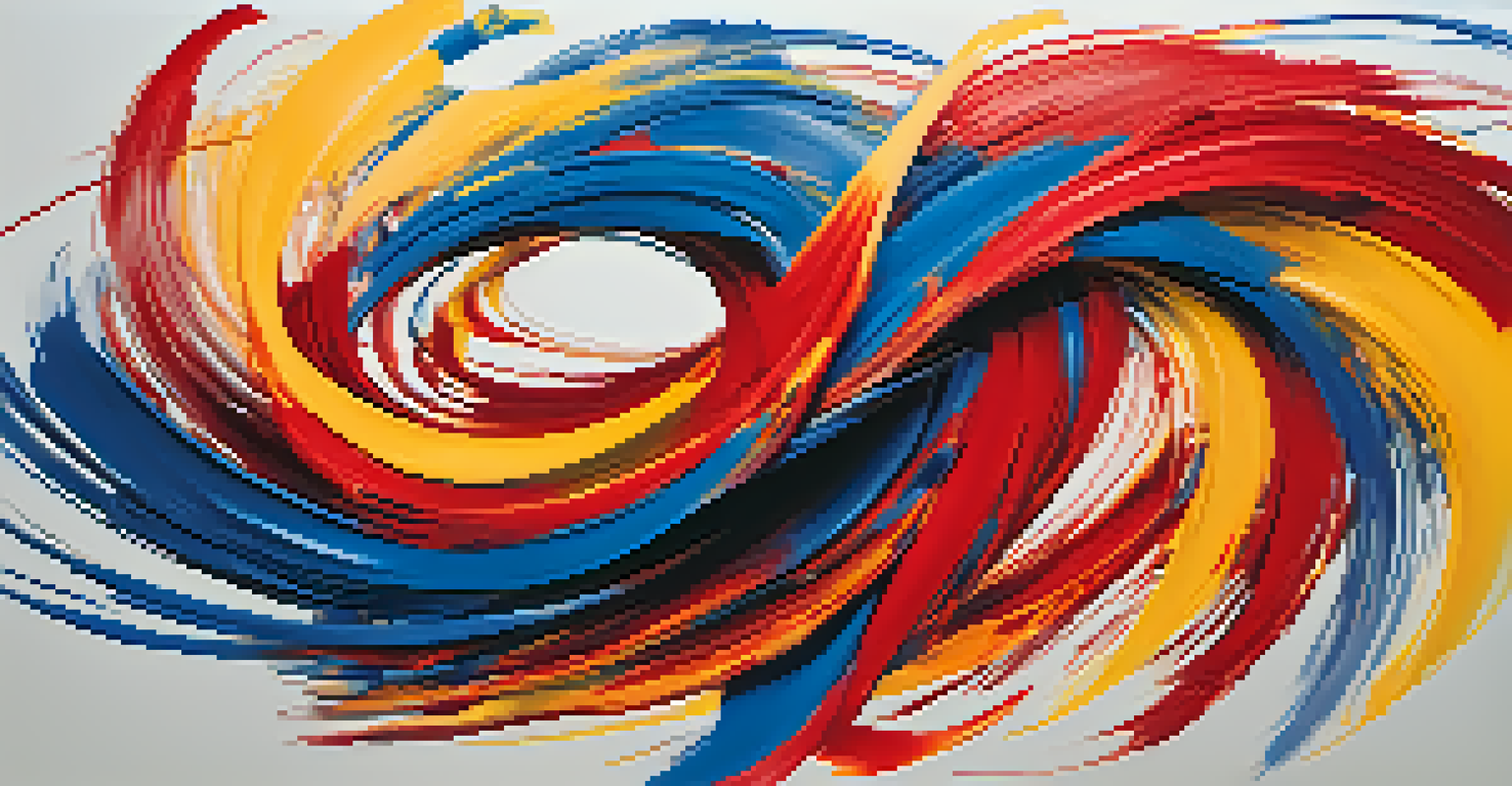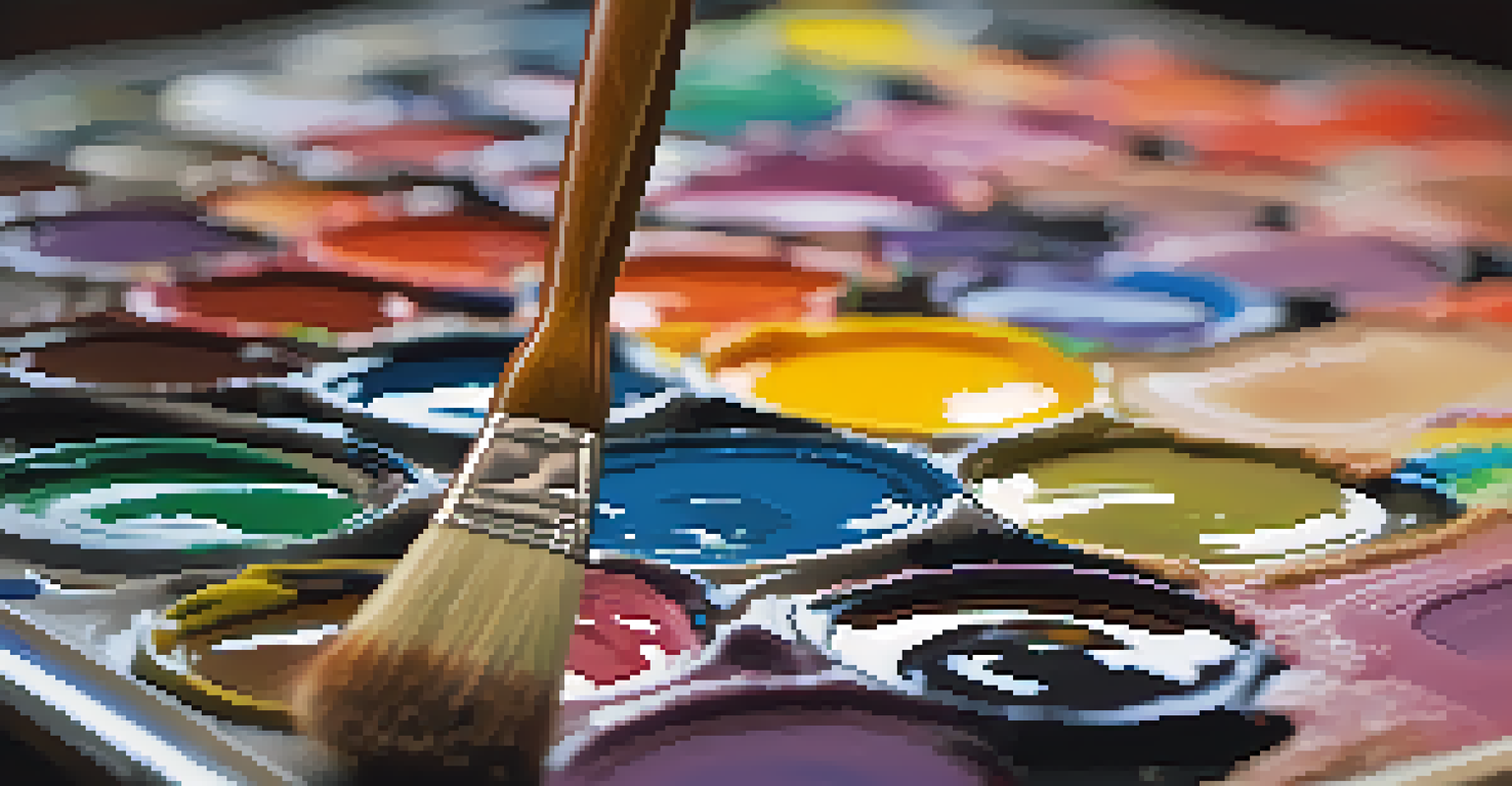Expressive Brush Strokes: Creating Mood in Your Paintings

Understanding the Power of Brush Strokes
Brush strokes are more than just a means of applying paint; they carry emotion and energy. Each stroke can communicate a different mood, whether it's the calmness of a gentle line or the chaos of a jagged one. By understanding how to manipulate these strokes, artists can evoke feelings that resonate with viewers on a deeper level.
Every artist dips his brush in his own soul, and paints his own nature into his pictures.
For example, a soft, sweeping stroke can create a sense of tranquility, reminiscent of a gentle breeze. Conversely, quick, sharp strokes can instill tension or urgency, much like the frantic energy of a busy street. Recognizing this potential helps artists choose their techniques thoughtfully, enhancing the overall impact of their work.
Ultimately, mastering brush strokes is about harnessing their expressive potential. The way you apply paint can transform an ordinary scene into a powerful emotional experience, inviting viewers to connect with your art in unique ways.
Choosing the Right Brush for Emotional Impact
Different brushes yield different results, influencing the mood of your painting. A wide flat brush can create bold, sweeping strokes, ideal for conveying grandeur or drama, whereas a fine-tipped brush allows for delicate details that evoke tenderness or introspection. The choice of brush is therefore a critical step in expressing the intended emotion.

For instance, if you're painting a stormy sea, using a stiff bristle brush with quick, choppy strokes can effectively depict the tumultuous nature of the waves. On the other hand, a soft, rounded brush might be more suitable for serene landscapes where a gentle touch is necessary. This strategic selection of tools enhances the emotional depth of your artwork.
Brush Strokes Convey Emotion
Understanding and manipulating brush strokes allows artists to evoke a wide range of emotions in their work.
Experimenting with various brushes can open new avenues for expression. As you discover the nuances of each tool, you’ll find that they can profoundly influence the mood and atmosphere of your pieces, making your art even more engaging.
Color Choices and Their Emotional Associations
Colors play a pivotal role in setting the mood of your painting, and when coupled with expressive brush strokes, they can create a powerful emotional narrative. For example, warm colors like red and orange can evoke feelings of passion or excitement, while cool colors such as blue and green tend to inspire calmness or sadness. Understanding these associations is key for any artist.
Color is the keyboard, the eyes are the harmonies, the soul is the piano with many strings.
When using brush strokes, think about how the color choices can enhance the emotional effect. A thick application of vibrant red with aggressive strokes can convey anger, while a soft wash of pale blue with gentle strokes can evoke a sense of peace and tranquility. This interplay between color and technique can dramatically alter how your art is perceived.
Ultimately, the synergy of color and brush strokes allows artists to craft complex emotional landscapes. By thoughtfully selecting colors and applying them with intention, you can guide viewers through the emotional journey of your artwork.
Creating Texture to Enhance Emotional Depth
Texture is another powerful element in painting that can enhance the emotional depth of your work. By varying the thickness of paint and the style of brush strokes, artists can create a tactile experience that adds layers of meaning. Rough, impasto techniques can evoke feelings of raw energy, while smooth, blended areas can suggest serenity and calm.
For example, a landscape painted with heavy, textured strokes can feel alive, almost pulsating with energy, while a portrait with fine, smooth strokes may convey a sense of vulnerability and tenderness. This contrast of textures can draw viewers in, inviting them to explore the emotional nuances of your painting.
Color Choices Impact Mood
The selection of colors, when combined with expressive brush strokes, plays a crucial role in enhancing the emotional narrative of a painting.
Incorporating texture into your brushwork not only engages the visual senses but also adds a physical dimension to the emotional experience. This layered approach encourages viewers to connect with your art on both an aesthetic and emotional level.
The Role of Composition in Expressive Painting
Composition is crucial in guiding the viewer's eye and enhancing the mood of your painting. How you arrange elements within your artwork can evoke different feelings. A balanced composition may inspire harmony, while an asymmetrical layout can create tension or excitement, complementing the emotions conveyed through brush strokes.
For instance, placing a solitary figure off-center can evoke feelings of isolation, while a central composition can instill a sense of stability and focus. By combining thoughtful composition with expressive brush strokes, you can create an impactful emotional narrative that resonates with the audience.
As you develop your skills, remember that composition is not just about aesthetics; it’s about storytelling. The way you structure your painting can amplify the emotions you wish to express, making your work more compelling and engaging.
Using Brush Strokes to Convey Movement and Emotion
Movement in painting can create a dynamic emotional experience, and brush strokes are the key to achieving this. By varying the direction and flow of your strokes, you can suggest motion, which can evoke feelings of excitement or restlessness. Imagine a dancer captured mid-leap; the energy of the brush strokes can mirror that sense of flight.
For example, swirling strokes can create a sense of chaos or passion, while long, flowing strokes can evoke grace and tranquility. This expressiveness allows artists to depict not just still images but the emotions that accompany movement, bringing their artwork to life.
Composition Guides Viewer Emotion
Thoughtful composition in art influences how viewers perceive emotions, adding depth and storytelling to the painting.
Incorporating movement through brush strokes invites viewers to experience the rhythm of your painting. It’s a powerful way to draw them into the emotional heart of your work, making them feel as if they are part of the scene.
Practice and Experimentation: The Path to Mastery
Like any skill, mastering the art of expressive brush strokes takes practice and experimentation. Spend time exploring different techniques, colors, and brushes to discover what resonates with you emotionally. Don't be afraid to make mistakes; they often lead to the most profound discoveries in your artistic journey.
Engaging in regular practice allows you to refine your technique and find your unique voice. As you experiment with various approaches, you’ll gain confidence in your ability to convey mood through brush strokes, which can transform your art into a more personal expression.

Ultimately, the journey of mastering expressive brush strokes is about embracing creativity and finding joy in the process. Each stroke you lay down is a step closer to understanding how to evoke emotion, making your art not only a reflection of your skills but also a mirror of your innermost feelings.